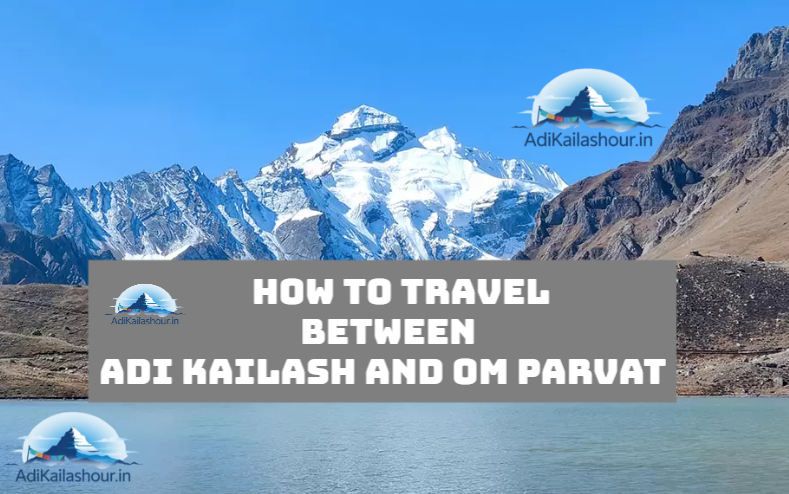Adi Kailash and Om Parvat are two distinct, yet intimately linked, holy sites nestled in the high Himalayas of Uttarakhand. Pilgrims often visit both as part of a single, profound journey. However, it’s crucial to understand that these two majestic spots are not directly adjacent with a connecting path. Instead, they are typically accessed as separate excursions from a common base village within the Inner Line area.
This guide will clarify the practicalities and distances involved in traveling between the experiences of Adi Kailash and Om Parvat.
Distance Between Adi Kailash and Om Parvat (via common base camp)
Since direct travel between the Adi Kailash viewpoint (Jolingkong/Parvati Sarovar) and the Om Parvat viewpoint (Nabidhang) is not how the pilgrimage is typically conducted, the “distance between them” is best understood by their individual distances from a central hub.
- Common Base Camp: The journey to both Adi Kailash and Om Parvat primarily originates from a base village like Gunji or Nabi, located within the restricted Inner Line area. This is where pilgrims usually stay overnight.
- Distance from Base Camp to Adi Kailash Viewpoint: Approximately 20-25 kilometers (one way) by 4×4 vehicle to Jolingkong, plus a short trek.
- Distance from Base Camp to Om Parvat Viewpoint: Approximately 15-25 kilometers (one way) by 4×4 vehicle to Nabidhang.
How to Travel Between Adi Kailash and Om Parvat (from your base)
After reaching the Inner Line area and settling into a base camp like Gunji or Nabi (which itself is accessed by a 4×4 from Dharchula, a journey of about 70-80 km), you will typically undertake two separate day trips to visit each sacred site.
Stage 1: From Base Camp (Gunji/Nabi) to Adi Kailash Viewpoint
This journey takes you to the closest motorable point for viewing Adi Kailash, a mountain revered as a replica of Mount Kailash.
- Mode of Transport: The primary mode of transport is by 4×4 vehicle (such as a Bolero or similar SUV). These specialized vehicles are essential due to the challenging and rugged mountain roads.
- Journey Details:
- Distance: Approximately 20-25 kilometers from Gunji/Nabi to Jolingkong, which is the motorable base for Adi Kailash.
- Time: The drive typically takes about 1-2 hours one way, depending on road conditions and weather.
- Final Approach: From Jolingkong, there is usually a gentle trek of about 1-3 kilometers to reach the serene Parvati Sarovar (Gauri Kund) and gain the best views of Adi Kailash mountain.
- Return: After spending time in this sacred area, you will return to your base camp in Gunji or Nabi for the night.
Stage 2: From Base Camp (Gunji/Nabi) to Om Parvat Viewpoint
This excursion takes you to Nabidhang, the famous viewpoint for Om Parvat, known for its unique natural “Om” symbol formed by snow.
- Mode of Transport: Similar to the Adi Kailash trip, this journey is also undertaken by 4×4 vehicle.
- Journey Details:
- Distance: Approximately 15-25 kilometers from Gunji/Nabi to Nabidhang (the Om Parvat viewpoint).
- Time: The drive typically takes about 1-2 hours one way, depending on road conditions and any checkpoints.
- Viewing Om Parvat: The remarkable “Om” symbol on Om Parvat is clearly visible directly from the roadside at Nabidhang, meaning a significant trek is generally not required to witness this natural wonder. This journey often includes stops at other significant points like Kalapani (source of the Kali River) and Vyas Gufa (Vyas Cave).
- Return: After the darshan of Om Parvat, you will return to your base camp in Gunji or Nabi, or continue back towards Dharchula as per your itinerary.
Key Considerations for These Journeys
- Inner Line Permit (ILP): Crucially, these areas are within the restricted Inner Line. An ILP, obtained in Dharchula, is mandatory and will be checked at various points along both routes.
- Road Conditions: The roads in this region are mostly unpaved mountain tracks. They can be rough, narrow, and prone to blockages during heavy rain or snowfall. Travel is dependent on these conditions.
- Tour Operators: Due to the specialized vehicles, permits, and remote nature of the region, most pilgrims undertake these journeys as part of an organized tour package. Tour operators manage these complex logistics for you.
- Acclimatization: Both Jolingkong and Nabidhang are at high altitudes. Proper acclimatization in places like Gunji/Nabi is vital before undertaking these day trips.
- Mobile Connectivity: Mobile network is very limited or non-existent in many parts of these routes.
Understanding that Adi Kailash and Om Parvat are two separate, distinct experiences accessed from a common base camp ensures you can plan your sacred journey effectively and appreciate the unique beauty and spiritual significance of each.

